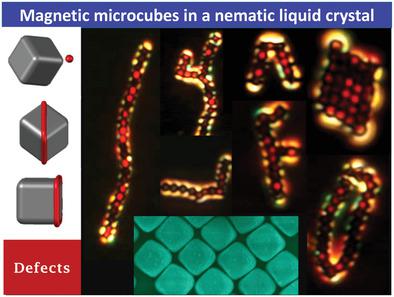当前位置:
X-MOL 学术
›
Adv. Opt. Mater.
›
论文详情
Our official English website, www.x-mol.net, welcomes your feedback! (Note: you will need to create a separate account there.)
Orientation Dependent Interaction and Self‐Assembly of Cubic Magnetic Colloids in a Nematic Liquid Crystal
Advanced Optical Materials ( IF 9 ) Pub Date : 2020-01-22 , DOI: 10.1002/adom.201901585 Devika Venkuzhy Sudhakaran 1 , Ravi Kumar Pujala 2 , Surajit Dhara 1
Advanced Optical Materials ( IF 9 ) Pub Date : 2020-01-22 , DOI: 10.1002/adom.201901585 Devika Venkuzhy Sudhakaran 1 , Ravi Kumar Pujala 2 , Surajit Dhara 1
Affiliation

|
Spherical microparticles dispersed in nematic liquid crystals have been extensively investigated in the past years. Here, experimental studies are reported on the elastic deformation, colloidal interaction, and self‐assembly of hematite microcubes with homeotropic surface anchoring in a nematic liquid crystal. It is demonstrated that the colloidal interaction and self‐assembly of cubic colloids are orientation dependent. In a notable departure from the conventional microspheres, the microcubes stabilize diverse structures, such as bent chains, branches, kinks, and closed‐loops. The microcubes reorient under external rotating magnetic field, thereby experiencing an elastic torque in the medium, which allows us to measure the magnetic moment through competition between elastic and magnetic torques. The findings envisage that the faceted magnetic colloids in liquid crystals are potential for developing new functional magnetic materials with specific morphologies.
中文翻译:

向列液晶中立方磁性胶体的取向依赖性相互作用和自组装
近年来,已经广泛研究了分散在向列型液晶中的球形微粒。在这里,实验研究报道了赤铁矿微立方体的弹性变形,胶体相互作用和自组装以及在向列液晶中的垂直表面锚固。结果表明,立方胶体的胶体相互作用和自组装是取向依赖性的。与传统的微球体明显不同的是,微立方体可稳定各种结构,例如弯曲的链,分支,扭结和闭环。微型立方体在外部旋转磁场下重新定向,从而在介质中经历弹性转矩,这使我们能够通过弹性转矩和磁性转矩之间的竞争来测量磁矩。
更新日期:2020-04-06
中文翻译:

向列液晶中立方磁性胶体的取向依赖性相互作用和自组装
近年来,已经广泛研究了分散在向列型液晶中的球形微粒。在这里,实验研究报道了赤铁矿微立方体的弹性变形,胶体相互作用和自组装以及在向列液晶中的垂直表面锚固。结果表明,立方胶体的胶体相互作用和自组装是取向依赖性的。与传统的微球体明显不同的是,微立方体可稳定各种结构,例如弯曲的链,分支,扭结和闭环。微型立方体在外部旋转磁场下重新定向,从而在介质中经历弹性转矩,这使我们能够通过弹性转矩和磁性转矩之间的竞争来测量磁矩。


























 京公网安备 11010802027423号
京公网安备 11010802027423号